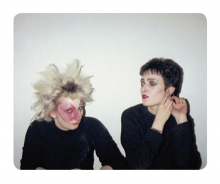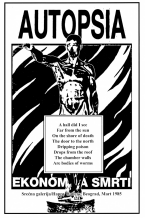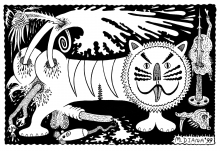| Revista Umělec 2002/4 >> Road trip Lithuania | Lista de todas las ediciones | ||||||||||||
|
|||||||||||||
Road trip LithuaniaRevista Umělec 2002/401.04.2002 Arunase Gudaitas | Lithuania | en cs |
|||||||||||||
|
Aš menininkas — Aš save myliu
Vincent van Gogh in one letter to his brother described a café as a place where one could easily go insane. The café in the Center for Contemporary Art (CAC) in Vilnius is such a place. Insider connoisseurs of the local scene consider it “very bohemian” and, indeed, in contrast to traditionally lackluster and overpriced eateries in museums, the atmosphere in the CAC comes across as authentic. A “mixzone” between outside reality and what we have come to understand as the world of art permeates the place. A sign written in two languages illuminated with white letters on two black boards: “Aš menininkas — I am an artist, Aš save myliu — I love myself.” A self-confident declaration or a sentimental admission? The result of a few too many glasses of the excellent Lithuanian beer Švyturis? Perhaps a warning for the ego-centric, or a mere artistic decoration for the café? It may seem odd, but CAC management plan to eliminate (reduce) the existential dimensions of the café. They wish to turn it into a peaceful and quiet place where tired museum visitors can rest up and intellectualize about this and that. Where curators of the center can invite foreign guests without risk of being offended. This is the reality of Lithuania today. The country is in the process of completely reconstructing itself to regain sovereignty after the fall of the iron curtain. Those who knew Lithuania some ten years ago gape at the remarkable transformation. The large historical UNESCO-protected heart of Vilnius has shed its former dullness and decay. The city parterre is now so dense with restaurants and designer shops that even westerners are surprised. One main street was rechristened by locals “Shoe Street,” indicating the nature of the shopping to be found there. And all the city hawkers have been shunted beyond the borders of the city center, the only exception being the stalls selling traditional souvenirs and amber jewelry. A dictatorship of cleanliness is the rule of law. A cleanness that has become a part of the new national, anti-Soviet identity. Under the Lithuanian flag Speaking of identity, it should be mentioned that Lithuanian artists use national symbols suspiciously often. And the Lithuanian flag — three horizontal stripes of yellow, green and red — is used most often. The history of the flag is a relatively short one. It was designed in 1918 in a public contest, and the colors have no historical connotations; the meaning is purely symbolic: the yellow represents the sun, the green is the land and the red is the fight. Aesthetically, these colors are less than harmonious. Artist Aurélia Maknyté interviewed citizens and asked them which color was their favorite and why. She recorded the answers, edited them into a video, and came up with a statistical record. The outcome of the questionnaire was not a graph, but a new flag, the thickness of each stripe referring to the percentage of its popularity. The most direct expression of the theme of national symbols can be seen in the work of Arunas Gudaitis, whose cartoonish drawings test the capacity of their meanings. Guaditis has a keen sense of observation and the ability to extract a maximum amount of substance from a minimum source. For example, his drawings of the flip side of Lithuanian coins depicts two variations on the national emblem of a rider on a horse. The tail of the horse juts upwards in one variation and downwards in the other. Quick alternation gives the impression that the rider is galloping forward. Basketball, Lithuanian’s most popular sport, could be also considered a national symbol. The feeling of euphoria after a victory, something usually reserved for sportsmen, was borrowed by Mindaugas Ratavitchius for one video in which he filmed himself holding aloft a cup won in a world championship by the national women’s team. A different point of view is expressed in the work of A. Maknyté. She collected photos of professional and homemade basketball hoops from rough countryside playgrounds. Different but also topical is Evaldas Jansas’ documentary video Body & Soul. The work is an attempt to work out the interconnecting relations between the body and soul, as well as their possible attitudes towards the world. Romantic crassness flung to the very edge of tolerability is fully expressed in the video Why dogs can do it anywhere and me not, which depicts the life of an artist in Paris living in a flat without a toilet. Sometimes it’s more difficult to defend one’s own human existence than that of an entire nation. Social Organism A must see for any foreigner interested in contemporary Lithuanian art is the market Gariunai, located about four kilometers from Vilnius. All guides claim that it’s the largest marketplace in the world. In addition, we are advised to visit only under the special guidance of someone acquainted with the local situation. One goes east for an adventure! But here we need to make a small digression, or rather a detour. A few kilometers from Vilnius, in the opposite direction from Gariunai, hovers the geographical center of Europe. Its demarcation is based on the measurement of the French Geographical Institute. Lithuanians are well aware of the difficulty to determine the exact mythical center of Europe; yet these exact geographical games are an important part of the national identity and travel industry. The same can be said of the surrounding countries. But let’s return to the marketplace of Gariunai. The architecture of this megalopolis of stalls is not much different from that of other similar places in neighboring countries. The golden age of Gariunai has probably passed. It belongs more to the 1990s than to the perspectives of the new century. The recession currently afflicting the Russian economy has affected sales of used western cars. “Car desovietizition” in Lithuania was, with a few exceptions, accomplished. The transformation of the Russian economy has also reduced local demand. The phenomenon of Gariunai became a theme for many local artists. Eglé Rakauskaité, for instance, spent an entire day filming one of the marketplace alleyways: the stall owners arriving in the morning, the unloading of the goods, the first customers, peak time and then close down. A viewer reared on TV documentaries will miss the story in this time-collecting film. Subconsciously he longs to see the details of the faces of the sellers and buyers, hear their opinions and complaints about life and their lot in it. But he gets nothing of the sort. Its emotional distance forces us to watch the marketplace as a social organism. A slightly different approach is taken by M. Ratavičius, who has made a cycle of large-format prints in which views of the stalls in the Gariunai marketplace alternate with photos of giant multinational hypermarkets. A transparent concept. A global cliché, so to speak. In the context of today’s Lithuania traditional understanding of these types of works fails to satisfy. The question at hand is whether Lithuanians regret the fading of traditional structures and fear new incoming global structures. Airing out the room Lithuanians always air their rooms. Even when the days are cold. They open their windows every time they enter the room. A foreigner may presume a deeper symbolic meaning. The musty odor of the past blows away and new, fresh air comes in. Only time will show to what extent this will be successful. Meanwhile, the cold rooms are an ideal place to sit and ponder Nordic mentality.
01.04.2002
Artículos recomendados
|
|||||||||||||
|
04.02.2020 10:17
Letošní 50. ročník Art Basel přilákal celkem 93 000 návštěvníků a sběratelů z 80 zemí světa. 290 prémiových galerií představilo umělecká díla od počátku 20. století až po současnost. Hlavní sektor přehlídky, tradičně v prvním patře výstavního prostoru, představil 232 předních galerií z celého světa nabízející umění nejvyšší kvality. Veletrh ukázal vzestupný trend prodeje prostřednictvím galerií jak soukromým sbírkám, tak i institucím. Kromě hlavního veletrhu stály za návštěvu i ty přidružené: Volta, Liste a Photo Basel, k tomu doprovodné programy a výstavy v místních institucích, které kvalitou daleko přesahují hranice města tj. Kunsthalle Basel, Kunstmuseum, Tinguely muzeum nebo Fondation Beyeler.
|



































 New book by I.M.Jirous in English at our online bookshop.
New book by I.M.Jirous in English at our online bookshop.
Comentarios
Actualmente no hay comentariosAgregar nuevo comentario